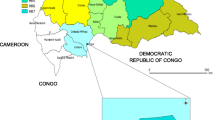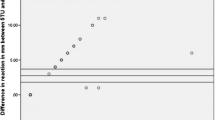Abstract
Although tuberculin test is widely used for detection ot tuberculous infection among children, there is no clear understanding about its performance and interpretation. This article has been written with the purpose of elucidating the performance and interpretation of standard tuberculin test, based on the experiences gained at the National Tuberculosis Institute, Bangalore and other centres.
The standard tuberculin test involves intradermal injection of "ITU PPD RT23 with Tween 80’ on the mid-volar aspect of forearm and measurement of the maximum transverse diameter of induration after 3 days. Larger the size of induration, higher is the probability of it being due to tuberculous infection. The majority of reactions with induration size of 15 mm and above are attributable to infection with tubercle bacilli, irrespective of BCG-vaccination status. While indurations of less than 5 mm indicate absence of any kind of tuberculin sensitivity, the majority of indurations in 5–9 mm range are usually of non-tuberculous nature. An induration of 10–14 mm requires more careful interpretation. It is more likely to be attributable to infection with tubercle bacilli in case of history of contact with smear positive case or among children with clinical findings of tuberculosis. However, the size of induration in an infected child may be diminished in the presence of immuno-suppressive conditions. One should also consider the purpose of the test while interpreting the test results.
Similar content being viewed by others
References
Chadha VK, Jagannatha PS, Nagaraj AV, Narayana Prasad D, Anantha N. A comparative study of tuberculin reactions to ITU and 2TU of PPD-RT 23.Indian J TB 2000; 47: 15–20.
World Health Organisation Tuberculosis Research Office. Effect of exposure of tuberculin to light.Bull Wld Hlth Org 1955; 12: 179–188.
Caplin M.The Tuberculin Test in Clinical Practice : An Illustrated Guide. London; Bailliere Tindall.
American Thoracic Society. The tuberculin skin teststatement of American Thoracic Society, Medical Section of the American Lung Association.Ante Rev Res Dis 1981; 124: 356–363.
Swanson Beck J. Skin changes in the tuberculin test.Tubercle 1991; 72: 81–87.
World Health Organisation Tuberculosis Research Office. Tuberculin reaction size on five consecutive days.Bull Wld Hlth Org 1955; 12: 189–196.
Kendig EL, Krickpatrick Barry V, Hans Carter W, Forrest Anne Hill, Kay Caldwell, Marielle Entwistle. Under-reading of the tuberculin skin test reaction.Chest 1988; 113: 1175–1177.
Shashidhara AN.An Introduction to Tuberculin Testing and BCG Vaccination. National Tuberculosis Institute, Bangalore, 1980.
Chakraborty AK, Ganapathy KT, Nair SS, Kul Bhushan. Prevalence of non-specific sensitivity to tuberculin in a south Indian rural population.Indian J Med Res 1976; 64(5): 639–651.
World Health Organisation Tuberculosis Research Office. Sensitivity of human populations to human and avian tuberculins.Bull Wld Hlth Org 1955; 12: 179–188.
Tuberculosis Prevention Trial, Madras. Trial of BCG vaccines in south India for tuberculosis prevention.IndianJ Med Res 1980; 72 (suppl): 1–74.
Edwards LB, Acqiavina FA, Livesay VT. Identification of tuberculosis infected.Ante Rev Resp Dis 1973; 108: 1334–1339.
Chadha VK, Jagannatha PS, Suryanarayana HV. Tuberculin sensitivity in BCG vaccinated children and its implications for ARI estimation.Indian J TB 2000; 47: 139–146.
World Health Organisation Tuberculosis Research Office. Certain characteristics of BCG-induced tuberculin sensitivity.Bull Wld Hlth Org 1955; 12: 123–141.
Gothi GD, Nair SS, Pyare Lai. Some epidemio-logical aspects of tuberculous disease and infection in pediatric age group in a rural community.Indian Pediatrics 1971; 8: 186–194.
National Tuberculosis Institute, Bangalore. Unpublished data.
National Tuberculosis Institute, Bangalore. Tuberculin testing in a partly BCG vaccinated population.Indian J TB 1992; 39: 149–158.
Chadha VK, Krishnamurthy MS, Shashidhara AN, Magesh V. Findings of a BCG Scar Survey in Bangalore city.Indian J Prev & Soc Med 1996; 28/3&4: 81–89.
Jorgen Nyboe. The efficacy of the tuberculin test — An analysis based on results from 33 countries.Bull Wld Hlth Org 1960; 22: 5–37.
Chakraborty AK, Chaudhury K, Sreenivas TR, Krishnamurthy MS, Shashidhara AN, Channabasavaiah R. Tuberculous infection in a rural population of south India — 23 year trend.IUAT & LD 1992; 73: 213–218.
Chadha VK, Krishnamurthy MS, Shashidhara AN, Jagannatha PS, Magesh V. Estimation of annual risk of tuberculosis infection among BCG vaccinated children.Indian J TB 1999; 46: 105–112.
Diba Siddiqi, Sanjoy Ghose, Krishnamurthy MS, Shashidhara AN. Tuberculosis infection rate in a rural population of Bikaner district.Indian J TB 1996; 43: 91–97.
Suryanaryana L, Suryanarayana HV, Jagannatha PS. Prevalence of pulmonary tuberculosis among children in a south Indian community.Indian J TB 1999; 46: 171–178.
Philip H Hopewell. Overview of clinical tuberculosis. TB — pathogenesis, protection and control; Washington D.C, Barry R Bloom, ASM press, 1994; 25–46.
Chadha VK, Suryanarayana HV, Krishnamurthy MS, Jagannatha PS, Shashidhara AN. Prevalence of undernutrition among peri-urban children and its influence on the estimation of annual risk of tuberculosis infection.Indian J TB 1997; 44: 67–71.
Klien RS, Flanigan T, Schuman P, Smith D, Vlahov D. The effect of immunodeficiency on cutaneous delayedtype hypersensitivity testing in HIV -infected women without anergy: implications for tuberculin testing,lnt J Tuberc & Lung Dis 1999; 3(8): 681–688.
Technical guidelines on Revised Strategy of National Tuberculosis Programme. Central TB Division, Directorate General of Health Services, Ministry of Health & Family Welfare, Government of India, 1997.
Krishnamurthy VV, Nair SS, Gothi GD, Chakraborty AK. Incidence of tuberculosis among newly infected population and its relation to the duration of infected status.Indian J TB 1976; 23: 3–7.
Hans L Rieder. Epidemiological basis of tuberculosis control, 1999. Published by International Union Against Tuberculosis & Lung Diseases.
Comstock GW. Tuberculosis conversions. True or False?Ame Rev Res Dis 1978; 118: 215–217.
Raj Narain, Nair SS, Ramanartha Rao G, Chandrasekhar P, Pyare Lai. Enhancing of tuberculin allergy by previous tuberculin testing.Bull WHO 1966; 34: 623–638.
Raj Narain, Gothi GD, Ganapathy KT, Shyama Sunder CV. Effect on tuberculin allergy of tuberculin tests given 18 months earlier.Indian J Med Res 1979; 69: 886–92.
Thompson NJ, Glassroth JN, Snider DE Jr, Farer LS. The Booster phenomenon in serial tuberculin testing.Ame Rev Res Dis 1979; 119: 587–597.
Raj Narain, Nair SS, Chandrasekhar P, Ramanatha Rao G. Problems connected with estimating the incidence of tuberculosis infection.Bull Wld Hlth Org 1966; 34: 605–622.
Author information
Authors and Affiliations
Corresponding author
Rights and permissions
About this article
Cite this article
Chadha, V.K. Tuberculin test. Indian J Pediatr 68, 53–58 (2001). https://doi.org/10.1007/BF02728860
Issue Date:
DOI: https://doi.org/10.1007/BF02728860




